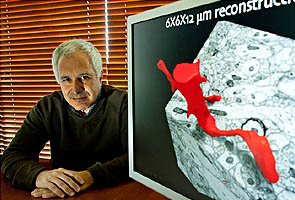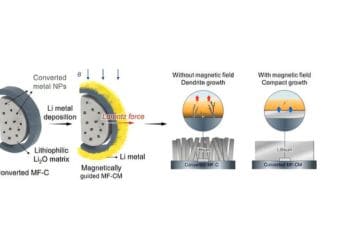- Home
- Others
- Others News
- Mapping the brain, slice by slice
Mapping the brain, slice by slice
By Ashlee Vance, New York Times | Updated: 5 June 2012 02:21 IST

Click Here to Add Gadgets360 As A Trusted Source

Advertisement
Dr. Jeff Lichtman likes his brains sliced thin -- very, very thin.
Dr. Lichtman and his team of researchers at Harvard have built some unusual contraptions that carve off slivers of mouse brains as part of a quest to understand how the mind works. Their goal is to run slice after minuscule slice under a powerful electron microscope, develop detailed pictures of the brain's complex wiring and then stitch the images back together. In short, they want to build a full map of the mind.
The field, at a very nascent stage, is called connectomics, and the neuroscientists pursuing it compare their work to early efforts in genetics. What they are doing, these scientists say, is akin to trying to crack the human genome -- only this time around, they want to find how memories, personality traits and skills are stored.
They want to find a connectome, or the mental makeup of a person.
"You are born with your genes, and they don't change afterward," said H. Sebastian Seung, a professor of computational neuroscience at the Massachusetts Institute of Technology who is working on the computer side of connectomics. "The connectome is a product of your genes and your experiences. It's where nature meets nurture."
The task is arduous and years from fruition, and even the biggest zealots acknowledge that their work may not pay off. But connectomics has gotten some meaningful financing: In September, the National Institutes of Health handed out $40 million in grants to researchers at Harvard, Washington University in St. Louis, the University of Minnesota and the University of California, Los Angeles, to pursue connectomics. Together, their research efforts comprise the Human Connectome Project.
Since the 1970s, researchers have only had one connectome to play with -- that of a worm with a measly 300 neurons. Now they are trying a mouse brain, with its 100 million neurons. So far the notion of creating a human-scale connectome -- which would illuminate all of the connections among more than 100 billion neurons and unravel the millions of miles of wires in the brain -- has proved too daunting.
The task at hand is somewhat similar to trying to untangle a bowl of spaghetti. Each individual spaghetti strand may touch tens of other strands as it weaves in a contorted fashion through the bowl. In this case, the researchers want to do the equivalent of seeing where all the strands connect at the atom level.
And because the brain's wiring is so densely packed, building a connectome stands as one of the most formidable data collection efforts ever concocted. About one petabyte of computer memory will be needed to store the images needed to form a picture of a one-millimeter cube of mouse brain, the scientists say. By comparison, it takes Facebook about one petabyte of data storage space to hold 40 billion photos.
"The world is not yet ready for the million-petabyte data set the human brain would be," Dr. Lichtman said. "But it will be."
Neuroscientists say that a connectome could give them myriad insights about the brain's function and prove particularly useful in the exploration of mental illness. For the first time, researchers and doctors might be able to determine how someone was wired -- quite literally -- and compare that picture with "regular" brains. Surgeons armed with a connectome might also be able to make more calculated cuts in the brain.
"The connectome project is going to show where all the white matter -- all the connecting fibers -- are," said Stanley Klein, a professor of optometry and vision science at the University of California, Berkeley. "The whole goal in something like a surgery for epilepsy is to delicately slice out some of the white matter without removing any cortex."
Dr. Klein says he has "zero question" that this type of surgery could benefit from developing a connectome.
Other scientists doubt that the results will match the effort. The comparisons to the genome prove haunting, and critics suggest that the connectome fans are wasting valuable research dollars and setting themselves up for a huge letdown.
"There are people that argue we still just don't know enough about the brain to know where to look for insights," said Bradley Voytek, a researcher at the Helen Wills Neuroscience Institute at the University of California, Berkeley. "They also contend that there is no possible way you can build a full connectome in any realistic time frame."
What's more, even if the researchers succeed, they will only produce a static picture of a brain frozen in time, rather than something that shows how a brain responds to different types of stimuli.
Scientists around the world, including Stephen J. Smith, a neuroscience professor at Stanford, and Gerald M. Rubin, a researcher with the Howard Hughes Medical Institute, have pushed past the naysayers and developed varying techniques for mapping the brains and nervous systems of human as well as other creatures.
"There are some people who say, 'Maybe you don't need this information, and given the expense of it, maybe you should put it off,' " said Dr. Lichtman, a professor of molecular and cellular biology at Harvard. "It's a fair controversy."
Harvard recruited Dr. Lichtman to push the connectome quest to its limits by tackling an entire mouse brain at the finest scale and allowed him to set up his own connectome research laboratory, staffed with four other people.
In the basement quarters that house Lichtman Lab, the researchers go to work anesthetizing mice, slicing open their rib cages and using the animals' circulatory systems to spread concoctions that preserve the flesh and tune it for the electron microscope. Now and again, a researcher will reach into a box of mouse food pellets littered around the lab for sustenance during the tedious work.
"They're not too bad," said Bobby Kasthuri, one of the researchers.
With the body prepared, the slicing can begin.
Machines built by Kenneth J. Hayworth, another one of the researchers, can sheer off slices of a mouse brain just 29.4 nanometers thin using a diamond knife blade. To provide a sense of the accomplishment, the researchers liken the cutting to shaving off the entire surface of a football field at a thickness of one-hundredth of an inch.
Mr. Hayworth devised techniques for floating the brain slivers across a tiny puddle of water where surface tension carries them to a clear plastic tape. The tape backing adds some sturdiness to the slivers and makes it possible to place scores of them on a silicon wafer that then goes under the electron microscope.
At Lichtman Lab, the researchers are marching across a mouse brain in linear fashion, gathering the slices, imaging them and then putting the puzzle back together. Once assembled by a computer, the images of the brain are beautiful.
Dr. Lichtman and his colleagues give individual brain cells unique colors, making it easier to follow the wiring of a single neuron's extensive axon and dendrite branches. The microscopes and computers they use can twist and turn these psychedelic images and zoom in and out at will.
It takes about three days for the researchers to carve 7,000 sections of a mouse's cerebral cortex.
"The cutting is easy," Dr. Lichtman said. "The big time sink is imaging."
Dr. Lichtman estimates it will be several years before they can contemplate a connectome of a mouse brain, but there are some technological advances on the horizon that could cut that time significantly. Needless to say, a human brain would be far more complex and time-consuming.
"Hopefully, we are returning with a burst of new energy to the question of how the brain is wired up," said Gary S. Lynch, a well-known brain researcher at the University of California, Irvine. "Lacking a blueprint, we're never going to get anywhere on the most profound and fun questions that drew everyone to neuroscience in the first place: what is thought, consciousness?"
A connectome would provide a far more detailed look at the brain's inner workings than current techniques that measure blood flow in certain regions. The researchers contend that it would literally show how people are wired and illuminate differences in the brains of people with mental illness.
As Mr. Kasthuri, the Harvard researcher, put it: "It will either be a great success story or a massive cautionary tale."
Dr. Lichtman and his team of researchers at Harvard have built some unusual contraptions that carve off slivers of mouse brains as part of a quest to understand how the mind works. Their goal is to run slice after minuscule slice under a powerful electron microscope, develop detailed pictures of the brain's complex wiring and then stitch the images back together. In short, they want to build a full map of the mind.
The field, at a very nascent stage, is called connectomics, and the neuroscientists pursuing it compare their work to early efforts in genetics. What they are doing, these scientists say, is akin to trying to crack the human genome -- only this time around, they want to find how memories, personality traits and skills are stored.
They want to find a connectome, or the mental makeup of a person.
"You are born with your genes, and they don't change afterward," said H. Sebastian Seung, a professor of computational neuroscience at the Massachusetts Institute of Technology who is working on the computer side of connectomics. "The connectome is a product of your genes and your experiences. It's where nature meets nurture."
The task is arduous and years from fruition, and even the biggest zealots acknowledge that their work may not pay off. But connectomics has gotten some meaningful financing: In September, the National Institutes of Health handed out $40 million in grants to researchers at Harvard, Washington University in St. Louis, the University of Minnesota and the University of California, Los Angeles, to pursue connectomics. Together, their research efforts comprise the Human Connectome Project.
Since the 1970s, researchers have only had one connectome to play with -- that of a worm with a measly 300 neurons. Now they are trying a mouse brain, with its 100 million neurons. So far the notion of creating a human-scale connectome -- which would illuminate all of the connections among more than 100 billion neurons and unravel the millions of miles of wires in the brain -- has proved too daunting.
The task at hand is somewhat similar to trying to untangle a bowl of spaghetti. Each individual spaghetti strand may touch tens of other strands as it weaves in a contorted fashion through the bowl. In this case, the researchers want to do the equivalent of seeing where all the strands connect at the atom level.
And because the brain's wiring is so densely packed, building a connectome stands as one of the most formidable data collection efforts ever concocted. About one petabyte of computer memory will be needed to store the images needed to form a picture of a one-millimeter cube of mouse brain, the scientists say. By comparison, it takes Facebook about one petabyte of data storage space to hold 40 billion photos.
"The world is not yet ready for the million-petabyte data set the human brain would be," Dr. Lichtman said. "But it will be."
Neuroscientists say that a connectome could give them myriad insights about the brain's function and prove particularly useful in the exploration of mental illness. For the first time, researchers and doctors might be able to determine how someone was wired -- quite literally -- and compare that picture with "regular" brains. Surgeons armed with a connectome might also be able to make more calculated cuts in the brain.
"The connectome project is going to show where all the white matter -- all the connecting fibers -- are," said Stanley Klein, a professor of optometry and vision science at the University of California, Berkeley. "The whole goal in something like a surgery for epilepsy is to delicately slice out some of the white matter without removing any cortex."
Dr. Klein says he has "zero question" that this type of surgery could benefit from developing a connectome.
Other scientists doubt that the results will match the effort. The comparisons to the genome prove haunting, and critics suggest that the connectome fans are wasting valuable research dollars and setting themselves up for a huge letdown.
"There are people that argue we still just don't know enough about the brain to know where to look for insights," said Bradley Voytek, a researcher at the Helen Wills Neuroscience Institute at the University of California, Berkeley. "They also contend that there is no possible way you can build a full connectome in any realistic time frame."
What's more, even if the researchers succeed, they will only produce a static picture of a brain frozen in time, rather than something that shows how a brain responds to different types of stimuli.
Scientists around the world, including Stephen J. Smith, a neuroscience professor at Stanford, and Gerald M. Rubin, a researcher with the Howard Hughes Medical Institute, have pushed past the naysayers and developed varying techniques for mapping the brains and nervous systems of human as well as other creatures.
"There are some people who say, 'Maybe you don't need this information, and given the expense of it, maybe you should put it off,' " said Dr. Lichtman, a professor of molecular and cellular biology at Harvard. "It's a fair controversy."
Harvard recruited Dr. Lichtman to push the connectome quest to its limits by tackling an entire mouse brain at the finest scale and allowed him to set up his own connectome research laboratory, staffed with four other people.
In the basement quarters that house Lichtman Lab, the researchers go to work anesthetizing mice, slicing open their rib cages and using the animals' circulatory systems to spread concoctions that preserve the flesh and tune it for the electron microscope. Now and again, a researcher will reach into a box of mouse food pellets littered around the lab for sustenance during the tedious work.
"They're not too bad," said Bobby Kasthuri, one of the researchers.
With the body prepared, the slicing can begin.
Machines built by Kenneth J. Hayworth, another one of the researchers, can sheer off slices of a mouse brain just 29.4 nanometers thin using a diamond knife blade. To provide a sense of the accomplishment, the researchers liken the cutting to shaving off the entire surface of a football field at a thickness of one-hundredth of an inch.
Mr. Hayworth devised techniques for floating the brain slivers across a tiny puddle of water where surface tension carries them to a clear plastic tape. The tape backing adds some sturdiness to the slivers and makes it possible to place scores of them on a silicon wafer that then goes under the electron microscope.
At Lichtman Lab, the researchers are marching across a mouse brain in linear fashion, gathering the slices, imaging them and then putting the puzzle back together. Once assembled by a computer, the images of the brain are beautiful.
Dr. Lichtman and his colleagues give individual brain cells unique colors, making it easier to follow the wiring of a single neuron's extensive axon and dendrite branches. The microscopes and computers they use can twist and turn these psychedelic images and zoom in and out at will.
It takes about three days for the researchers to carve 7,000 sections of a mouse's cerebral cortex.
"The cutting is easy," Dr. Lichtman said. "The big time sink is imaging."
Dr. Lichtman estimates it will be several years before they can contemplate a connectome of a mouse brain, but there are some technological advances on the horizon that could cut that time significantly. Needless to say, a human brain would be far more complex and time-consuming.
"Hopefully, we are returning with a burst of new energy to the question of how the brain is wired up," said Gary S. Lynch, a well-known brain researcher at the University of California, Irvine. "Lacking a blueprint, we're never going to get anywhere on the most profound and fun questions that drew everyone to neuroscience in the first place: what is thought, consciousness?"
A connectome would provide a far more detailed look at the brain's inner workings than current techniques that measure blood flow in certain regions. The researchers contend that it would literally show how people are wired and illuminate differences in the brains of people with mental illness.
As Mr. Kasthuri, the Harvard researcher, put it: "It will either be a great success story or a massive cautionary tale."
Comments
Get your daily dose of tech news, reviews, and insights, in under 80 characters on Gadgets 360 Turbo. Connect with fellow tech lovers on our Forum. Follow us on X, Facebook, WhatsApp, Threads and Google News for instant updates. Catch all the action on our YouTube channel.
Further reading:
Brain mapping, connectomics
Related Stories
Popular on Gadgets
- Samsung Galaxy Unpacked 2025
- ChatGPT
- Redmi Note 14 Pro+
- iPhone 16
- Apple Vision Pro
- Oneplus 12
- OnePlus Nord CE 3 Lite 5G
- iPhone 13
- Xiaomi 14 Pro
- Oppo Find N3
- Tecno Spark Go (2023)
- Realme V30
- Best Phones Under 25000
- Samsung Galaxy S24 Series
- Cryptocurrency
- iQoo 12
- Samsung Galaxy S24 Ultra
- Giottus
- Samsung Galaxy Z Flip 5
- Apple 'Scary Fast'
- Housefull 5
- GoPro Hero 12 Black Review
- Invincible Season 2
- JioGlass
- HD Ready TV
- Laptop Under 50000
- Smartwatch Under 10000
- Latest Mobile Phones
- Compare Phones
Latest Gadgets
- Huawei Nova 15
- Huawei Nova 15 Pro
- Huawei Nova 15 Ultra
- OnePlus 15R
- Realme Narzo 90x 5G
- Realme Narzo 90 5G
- Vivo S50 Pro Mini
- Vivo S50
- Asus ProArt P16
- MacBook Pro 14-inch (M5, 2025)
- Huawei MatePad 11.5 (2026)
- OnePlus Pad Go 2 (5G)
- Huawei Watch 10th Anniversary Edition
- OnePlus Watch Lite
- Acerpure Nitro Z Series 100-inch QLED TV
- Samsung 43 Inch LED Ultra HD (4K) Smart TV (UA43UE81AFULXL)
- Asus ROG Ally
- Nintendo Switch Lite
- Haier 1.6 Ton 5 Star Inverter Split AC (HSU19G-MZAID5BN-INV)
- Haier 1.6 Ton 5 Star Inverter Split AC (HSU19G-MZAIM5BN-INV)
© Copyright Red Pixels Ventures Limited 2025. All rights reserved.







![[Partner Content] OPPO Find X9 Two Week Experience: Here's Why It Stands Out](https://www.gadgets360.com/static/desktop/images/spacer.png)









